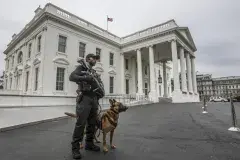 One of the Department’s top priorities is to resolutely protect Americans from terrorism and other homeland security threats by preventing nation-states and their representatives, transnational criminal organizations, and groups or individuals from engaging in terrorist or criminal acts that threaten the Homeland.
One of the Department’s top priorities is to resolutely protect Americans from terrorism and other homeland security threats by preventing nation-states and their representatives, transnational criminal organizations, and groups or individuals from engaging in terrorist or criminal acts that threaten the Homeland.
In recent years, terrorists and criminals have increasingly adopted new techniques and advanced tactics in an effort to circumvent homeland security and threaten the safety, security, and prosperity of the American public and our allies. The rapidly evolving threat environment demands a proactive response by DHS and its partners to identify, detect, and prevent attacks against the United States.
The Department of Homeland Security's counterterrorism responsibilities focus on four goals:

Effective homeland security operations rely on timely and actionable intelligence to accurately assess and prevent threats against the United States. Accordingly, DHS works diligently to improve intelligence collection, integration, analysis, and information sharing capabilities to ensure partners, stakeholders, and senior leaders receive actionable intelligence and information necessary to inform their decisions and operations. A critical and statutorily charged mission of DHS is to deliver intelligence and information to federal, state, local, and tribal governments and private sector partners. DHS has the broadest customer base for intelligence products of various subjects and classification requirements. This responsibility requires an integrated intelligence network to eliminate redundancies and a mission-focused approach to producing and sharing intelligence.
Related DHS Components
- U.S. Customs and Border Protection
- Cybersecurity & Infrastructure Security Agency
- Federal Emergency Management Agency
- U.S. Immigration and Customs Enforcement
- Transportation Security Administration
- U.S. Citizenship and Immigration Services
- U.S. Coast Guard
- U.S. Secret Service
- Headquarters Support Components

Terrorist threats to the United States have evolved considerably since the September 11th attacks. Despite our success in detecting and preventing multi-actor, complex terrorist attacks, terrorists continue plotting in search of any kind of vulnerability that may permit them to conduct an attack against the United States. While this significant threat looms, decentralized terrorist groups have exploited the Internet and social media to constantly spread terrorist propaganda and training material that inspire and recruit individuals within the United States to radicalize to violence. Terrorist narratives across the ideological spectrum increasingly encourage the use of simple tactics that target large public gatherings using vehicular attacks, small arms, homemade explosives, or chemical, biological, or radiological materials. These attacks often lack overt warning signs, which limits opportunities for intervention or apprehension.
To prevent these attacks, the Department and its partners must engage in a comprehensive counterterrorism approach to prevent both foreign and domestic terrorism and more decisively confronts the terror threat to the Homeland. The Department also requires the tools and capabilities necessary to address targeted violence in all its forms, including threats to our schools, infrastructure, and houses of worship.
Meanwhile, nation-states are actively attempting to undermine democratic institutions and the prosperity of the American people. Preventing adversaries from exerting direct or indirect influence on the United States is essential to homeland security. DHS is collaborating with state, local, and tribal governments and private sector partners to disrupt these activities and raise awareness among our citizens, while continuing to enforce protections against foreign investments into the United States that threaten national security.
Transnational criminal organizations and their offshoots also pose serious threats to the American people and the Homeland. Their crimes include trafficking and smuggling of humans, drugs, weapons, and wildlife, as well as money laundering, corruption, cybercrime, fraud, financial crimes, intellectual property theft, and the illicit procurement of export-controlled material and technology. DHS is using its full breadth of law enforcement, border security, immigration, travel security, and trade-based authorities to proactively prevent, identify, investigate, disrupt, and dismantle these organizations.
Related DHS Components

Making sure the protection and safety of our Nation’s highest elected leaders is a paramount responsibility that demands operational perfection. DHS maintains a highly skilled and motivated workforce combined with innovative technologies and advanced countermeasures to protect designated leadership, visiting foreign heads of state and government, and National Special Security Events.
In addition, DHS protects federal facilities and personnel across the United States; supports tribal, state, and local governments to protect events of national significance; and improves security for soft targets. In particular, DHS is leading efforts to defend soft targets by sharing intelligence bulletins and analysis with homeland security stakeholders, developing best practices to counter attacks against soft targets, promoting a dynamic process to assess soft targets and address security gaps, and investing in research and development for technological solutions. Together, these initiatives harden and help defend potential targets of terrorist attacks.
The Department also assesses risk to local special events occurring across the Nation. This assessment uses the Special Events Assessment Rating (SEAR) methodology to rank events by risk factors. DHS supports the highest risk events with Federal Coordinators to serve as representatives of the Secretary by engaging directly with our state and local partners to coordinate support that helps address safety and security capabilities shortfalls.
Related DHS Components

The spread of rapidly evolving and innovative technology, equipment, techniques, and knowledge presents new and emerging dangers for homeland security in the years ahead. Terrorists remain intent on acquiring weapons of mass destruction (WMD) capabilities, and rogue nations and non-state actors are aggressively working to develop, acquire, and modernize WMDs that they could use against the Homeland. Meanwhile, biological and chemical materials and technologies with dual use capabilities are more accessible throughout the global market. Due to the evolution of information and technologies, rogue nations and non-state actors have more opportunities to develop, acquire, and use WMDs than ever before. DHS is strengthening and integrating its detection and counter-measure capabilities to address this profound risk to the United States.
Similarly, the evolution of unmanned aircraft systems, artificial intelligence, and biotechnology increase opportunities for threat actors to acquire and use these capabilities against the United States and its interests. DHS is assessing how these technologies will affect homeland security and developing proactive solutions to limit future risk.
